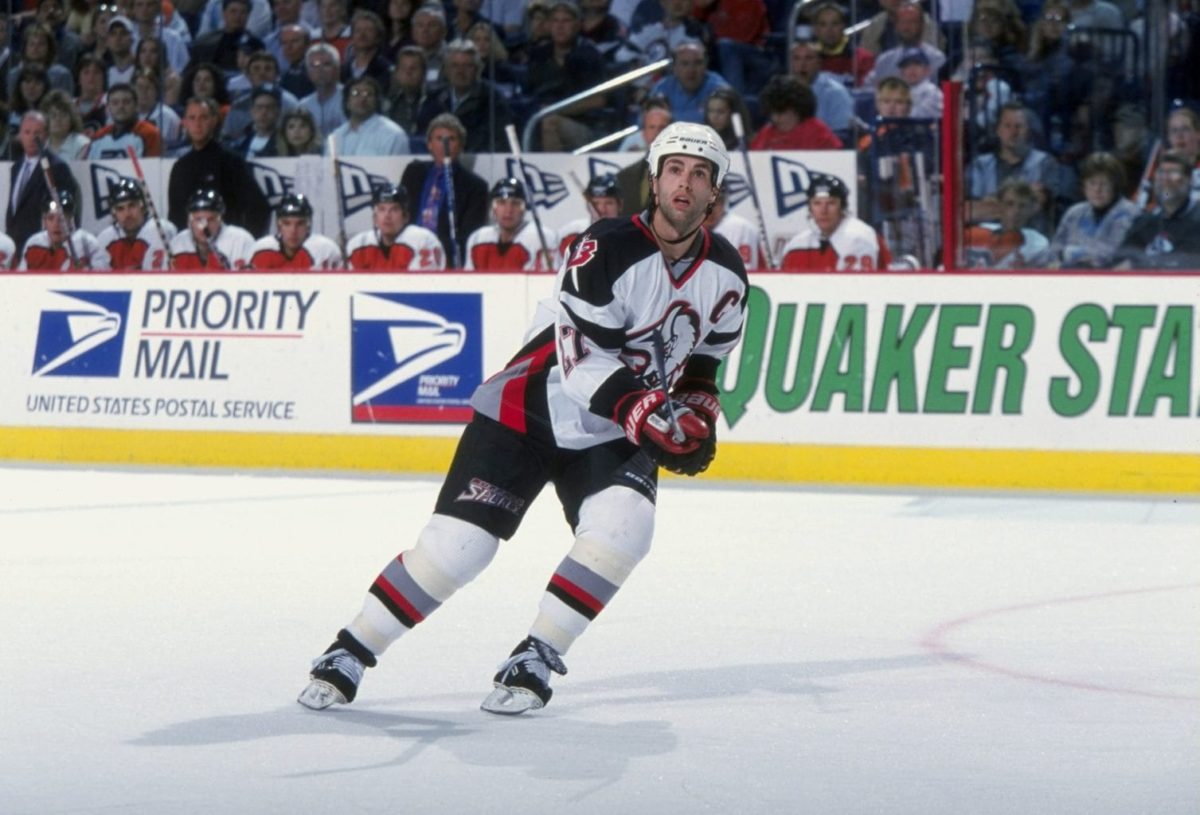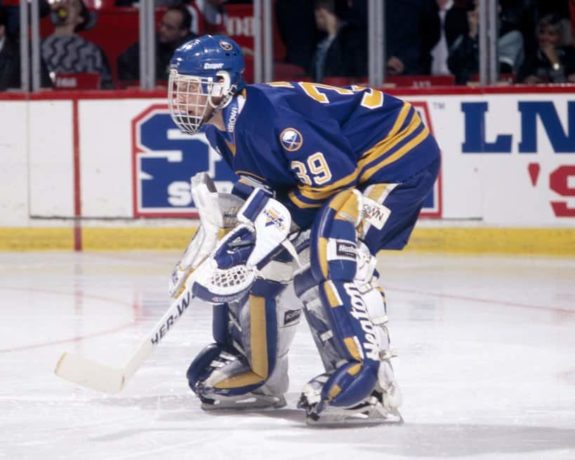When it comes to making trades, every team in professional sports has had both successes and failures, and the Buffalo Sabres are no different. In the team’s ongoing, 54-year history, some transactions have not aged well, while some have proved very beneficial.
In the past, we’ve looked at some of the former trades the Sabres have made that either aged poorly or became outright disasters. But what about the ones that worked out? Let’s be positive for a change and examine some of the transactions that went in Buffalo’s favor.
Whether because the team turned a little into a lot or its prognostication proved correct, here are some of the best deals the Sabres have made in their history, based on who/what was received in return. Though some may be obvious, some may also be a surprise when really thinking about it.
1995 – Michael Peca
Due to increasing financial constraints, it became evident that the Sabres would not be able to retain superstar sniper Alexander Mogilny and the team was forced to trade him away before he could walk in free agency. One of the NHL’s most electric scorers of the 1990s, he was immensely popular with fans and helped revitalize a Sabres offense that struggled in the second half of the 1980s.
At the 1995 NHL Draft, Buffalo sent Mogilny to the Vancouver Canucks, receiving Michael Peca, Mike Wilson and a 1995 first-round pick in return (from “Sabres Trade Mogilny To Canucks Draft Day Deal Opens New Era; Chops Payroll”, The Buffalo News, 7/9/1995). Though at the time it seemed like an outright steal on Vancouver’s part, the trade ended up working out very well for the Sabres, too.

Although there was no way he’d match Mogilny’s production, Peca proved to be the complete package and emerged as a star in his own right. Renowned for his combination of scoring ability, defensive prowess and physicality, he emerged as one of the NHL’s premier two-way forwards and won the Selke Trophy for the 1996-97 campaign. He became the Sabres’ captain the next season and helped lead the team to the 1999 Stanley Cup Final. His time with the Sabres came to an abrupt end when he sat out the entire 2000-01 campaign due to a contract impasse and he was traded to the New York Islanders at the 2001 Draft. Peca’s contributions are undeniable, however, and he was an essential part of the team’s late 90s success.
Also, the first-round pick they received became Jay McKee, who anchored the team’s defense for much of the next decade. Trading Mogilny may have been tough for fans to endure at the time, but the Sabres managed to turn a big negative into an even bigger positive.
2003 – Daniel Briere and Chris Drury
Darcy Regier isn’t remembered very fondly amongst Sabres fans, and their feelings are largely justified. Despite this, the controversial former general manager (GM) was able to pull off a few good moves in his day, and these two (which we’ll consider one entry since the players are so synonymous) were undoubtedly the best.
At the 2003 NHL Trade Deadline, the rebuilding Sabres sent the hulking 6-foot-4 Chris Gratton and a fourth-round selection to the then-Phoenix Coyotes in exchange for 5-foot-9 speedster Daniel Briere and a fourth-round pick. Four months later, they sent Steven Reinprecht and long-time defenseman Rhett Warrener to the Calgary Flames for Steve Begin and former Hobey Baker Award winner Chris Drury. At the time it may have seemed like the Sabres were simply attempting to transform their roster, but the moves quickly paid immense dividends.
Related: Drury and Briere: What Might Have Been
Briere and Drury formed a new core and their abilities complemented each other magnificently. The combination of the former’s skating and scoring prowess and the latter’s leadership and clutch situational ability reinvigorated the downtrodden Sabres and the duo eventually became co-captains under then-head coach Lindy Ruff. With them at the helm, the team underwent a remarkable transformation and nearly made it to the Stanley Cup Final in back-to-back seasons in 2006 and 2007.
Of course, their successes will forever be overshadowed by the circumstances under which both departed in the summer of 2007 and how the Sabres plummeted afterwards. While fans will never forgive Regier for that, it shouldn’t take away from how impressive both trades were.
1991 – Pat LaFontaine
In Oct. 1991, then Sabres’ GM Gerry Meehan sent a package headlined by Pierre Turgeon, the first-overall selection of the 1987 Draft, to the Islanders in exchange for a package headlined by another superstar, Pat LaFontaine. Frustrated with the Isles’ struggles at the time, the American refused to report for the season and forced New York to trade him.
The Sabres didn’t need to get rid of Turgeon by any means, as he helped bring the team back to life from their doldrums of the late-1980s, but LaFontaine ultimately proved to be the better fit and quickly became a force in Buffalo. Thanks to the instant cohesion he found with Mogilny, he scored 93 points in just 57 games in his first season in Western New York. The next season he was named captain and scored 148 points, winning the Lady Byng Trophy for sportsmanship whilst finishing second for the Hart Trophy as NHL MVP.
Unfortunately, LaFontaine struggled with injuries immensely during his time with the Sabres and the team recommended he retire after he sustained his fifth concussion early in the 1996-97 season. Determined to continue playing, he was traded to the New York Rangers, but was forced to retire after the 1997-98 campaign after suffering yet another concussion. The Sabres retired his No.16 in 2006 and he remains one of the most beloved figures in team history.
1972 – Rene Robert
The Sabres have pulled off some remarkable steals in their history, and this one may have been the first. Eddie Shack is one of the most memorable players in hockey and his on-ice antics have become the stuff of legend. After a season and a half with Buffalo, he was traded to the Pittsburgh Penguins in March 1972 in exchange for 23-year-old, up-and-coming winger Rene Robert.
That’s right, the Sabres received one of their greatest players in exchange for an agitator. Robert proved to be the missing piece and formed one of the greatest lines of all time with fellow Quebecois Rick Martin and Gilbert Perreault.
As one of the most iconic players in franchise history, he became a household name amongst Sabres fans, with his greatest moment coming when he scored the overtime winner in the legendary “Fog Game” of the 1975 Stanley Cup Final. He was traded to the Colorado Rockies in 1979, but his popularity in Buffalo remained until he sadly passed away in 2021. His No. 14 hangs from the rafters of KeyBank Center next to Perreault’s No. 11 and Martin’s No. 7.
2002 – Jochen Hecht
One of the better moves the Sabres made during their early 2000s rebuilding period is one that frequently flies under the radar. At the 2002 NHL Draft, the team sent two second-round picks to the Edmonton Oilers for winger Jochen Hecht.
Though never a marquee player, Hecht spent the remainder of his career with the Sabres and turned into a solid, dependable piece of the core. A reliable two-way forward, he never contributed more than 60 points in a season but was always integral to the roster, especially during the team’s back-to-back runs to the Eastern Conference Final. The aforementioned departures of Briere and Drury left the team in dire need of leadership and the German was one of the players who stepped up to help fill the void, as made evident when he was named captain twice the following season when it was rotated each month.
He retired at the conclusion of the lockout-shortened 2012-13 season after 10 seasons and 613 games played in Buffalo, in which he recorded 345 points. His name isn’t up there with the all-time greats in franchise history, but Hecht always served his role and deserves to be recognized as one of the most underrated acquisitions the Sabres have made over the years.
1992 – Dominik Hasek
The greatest trade the Sabres ever made is also one of the most outright robberies in NHL history. The summer after the 1991-92 season they finally succeeded in trading for a goaltender from the Chicago Blackhawks that they had attempted to acquire a few times before. The Blackhawks had Ed Belfour entrenched in goal and saw no need for backup Dominik Hasek despite his standout performance in that year’s Stanley Cup Final.
As a result, they traded him to the Sabres for the cost of goaltender Stephane Beauregard and future considerations that turned into a 1993 fourth-round pick the Blackhawks used to select Eric Daze. That’s right, the Sabres acquired one of the best players of all time in exchange for a goaltender that never played a game for the team and future considerations.

It’s safe to assume Chicago may have regretted the decision. In Buffalo, Hasek blossomed into a superstar the likes of which the game had never seen, with his unorthodox style making him a sensation. The Czech spent nine seasons with the Sabres and won the Vezina Trophy six times in that span in addition to back-to-back Hart Trophies. He’s one of just seven goaltenders to win the Hart and the only one to win it more than once. He was never able to capture the Stanley Cup in Buffalo, though he nearly did so almost single-handedly in 1999.
With the Sabres headed downward after the 2000-01 season, they traded Hasek to the Detroit Red Wings in (ironically) one of the worst deals the team has ever made. The Sabres retired his No. 39 in 2015, making him the first goaltender in franchise history to receive the honor. Arguably the greatest player to ever wear a Sabres jersey, he’s without question the best trade the team has ever made as well.
Sabres Could Have Big Trades On the Horizon
With the amount of managerial ineptitude the Sabres have endured over the past decade, it’s easy to forget that they’ve had a large amount of good fortune in that area over their history. Current GM Kevyn Adams has stayed away from big trades since taking the helm, but it’s possible that something could be coming down the line if the team improves this year. If that’s the case, hopefully, fortune will continue to be their friend.
